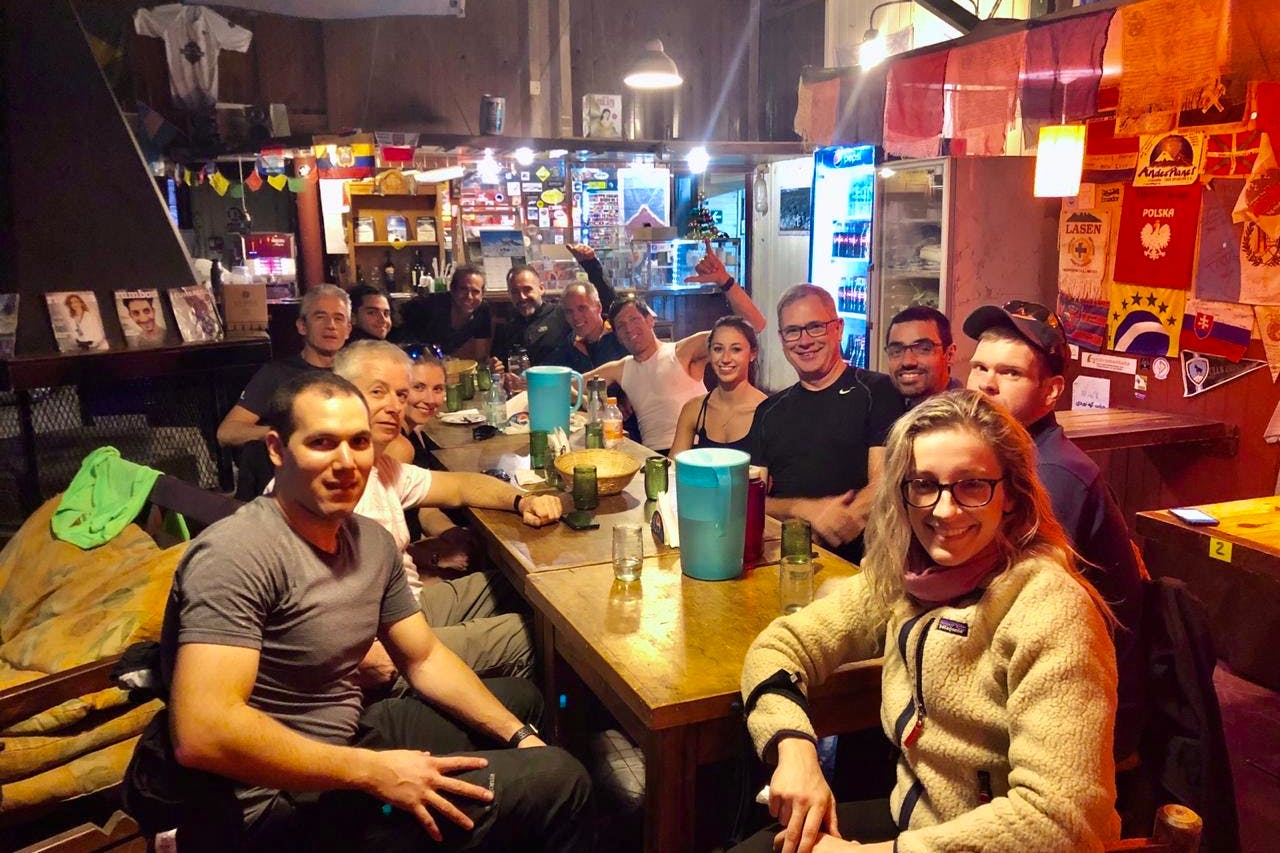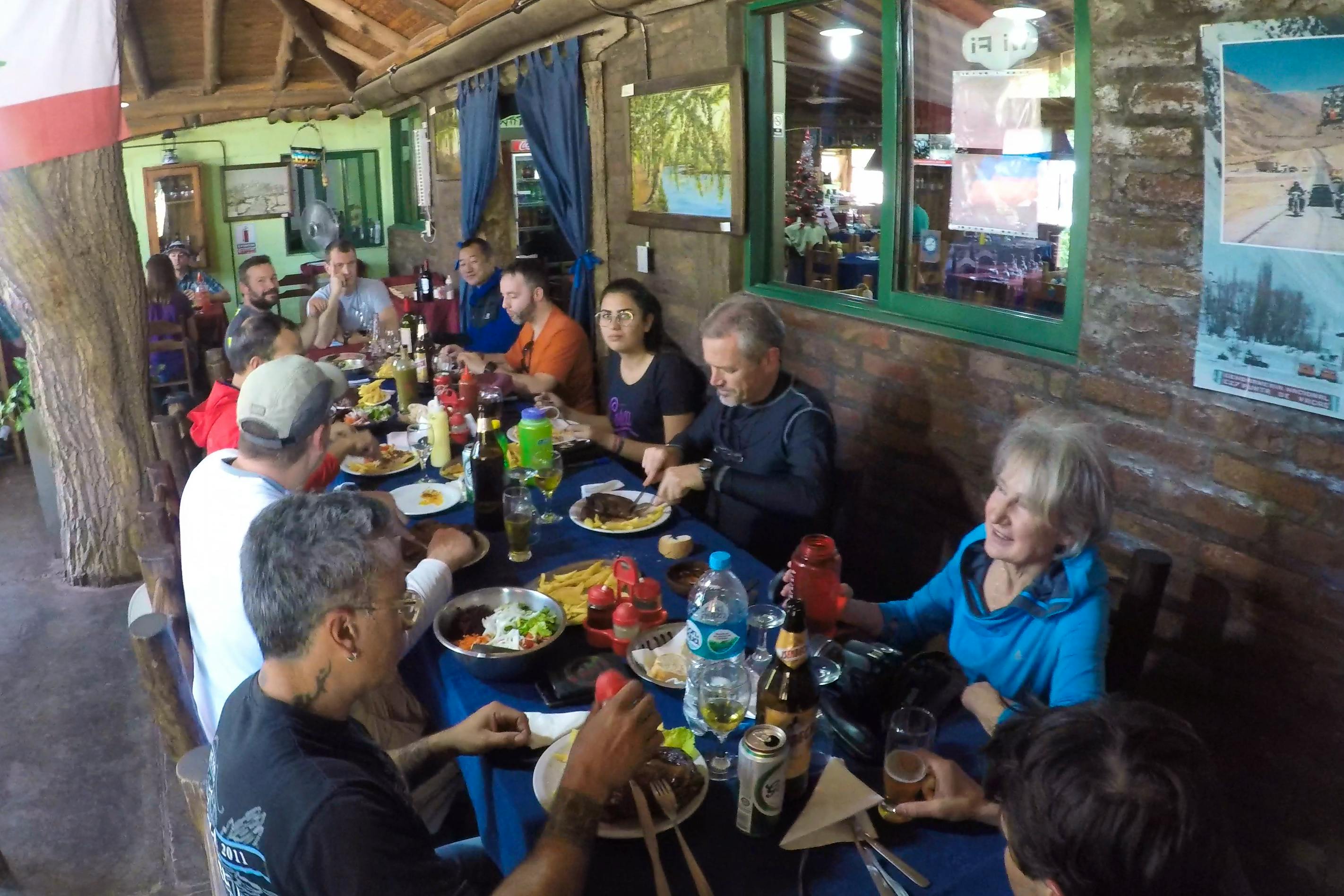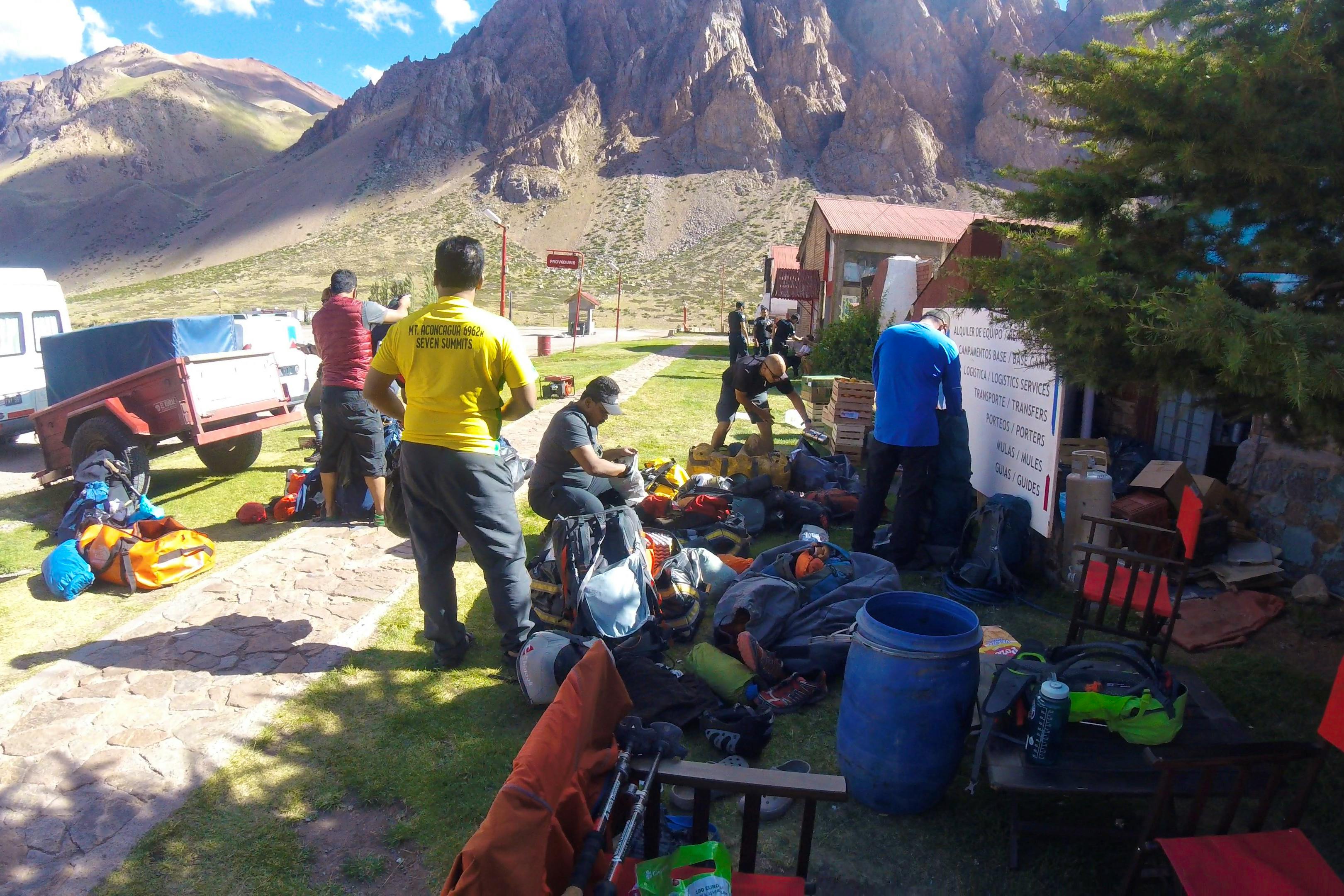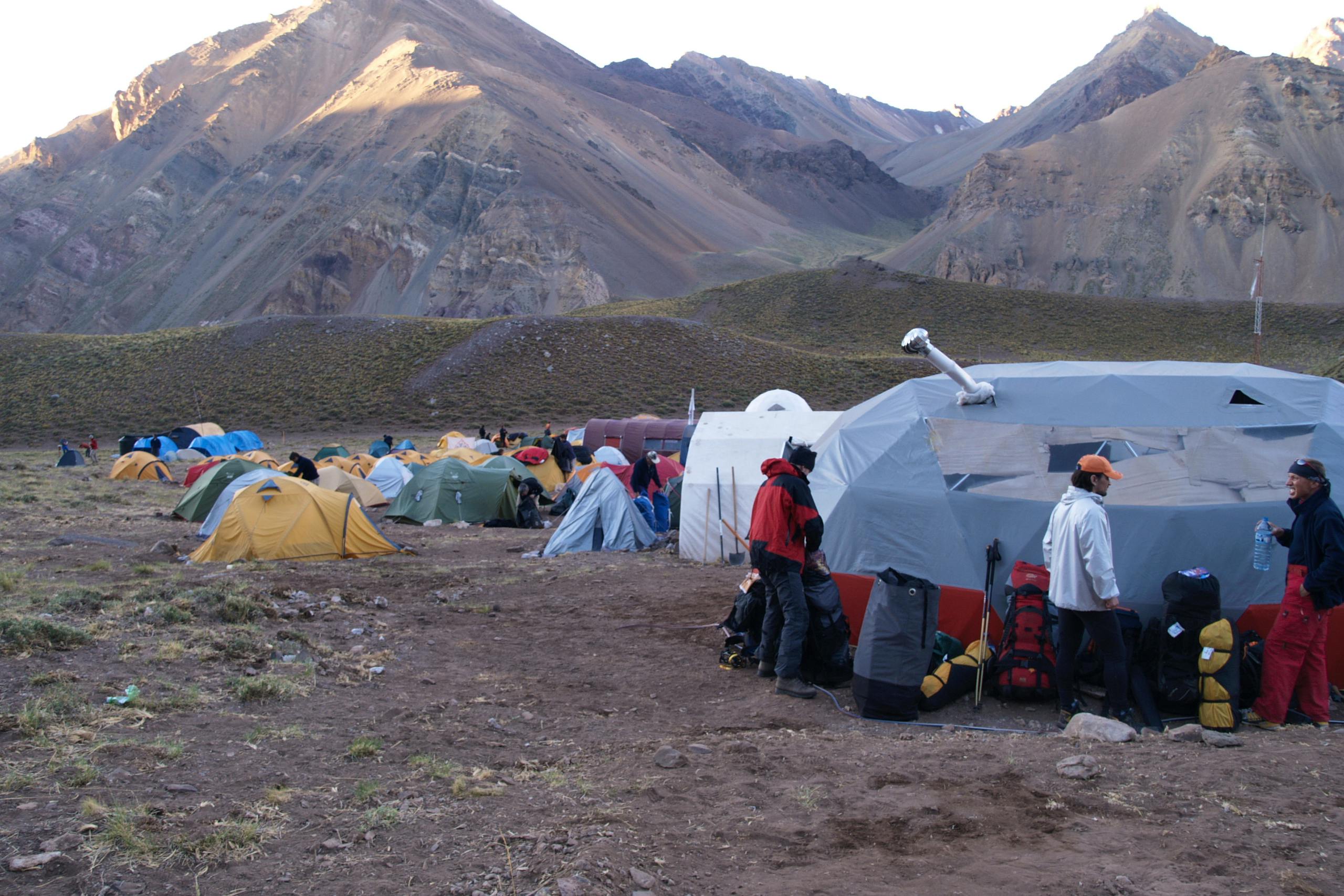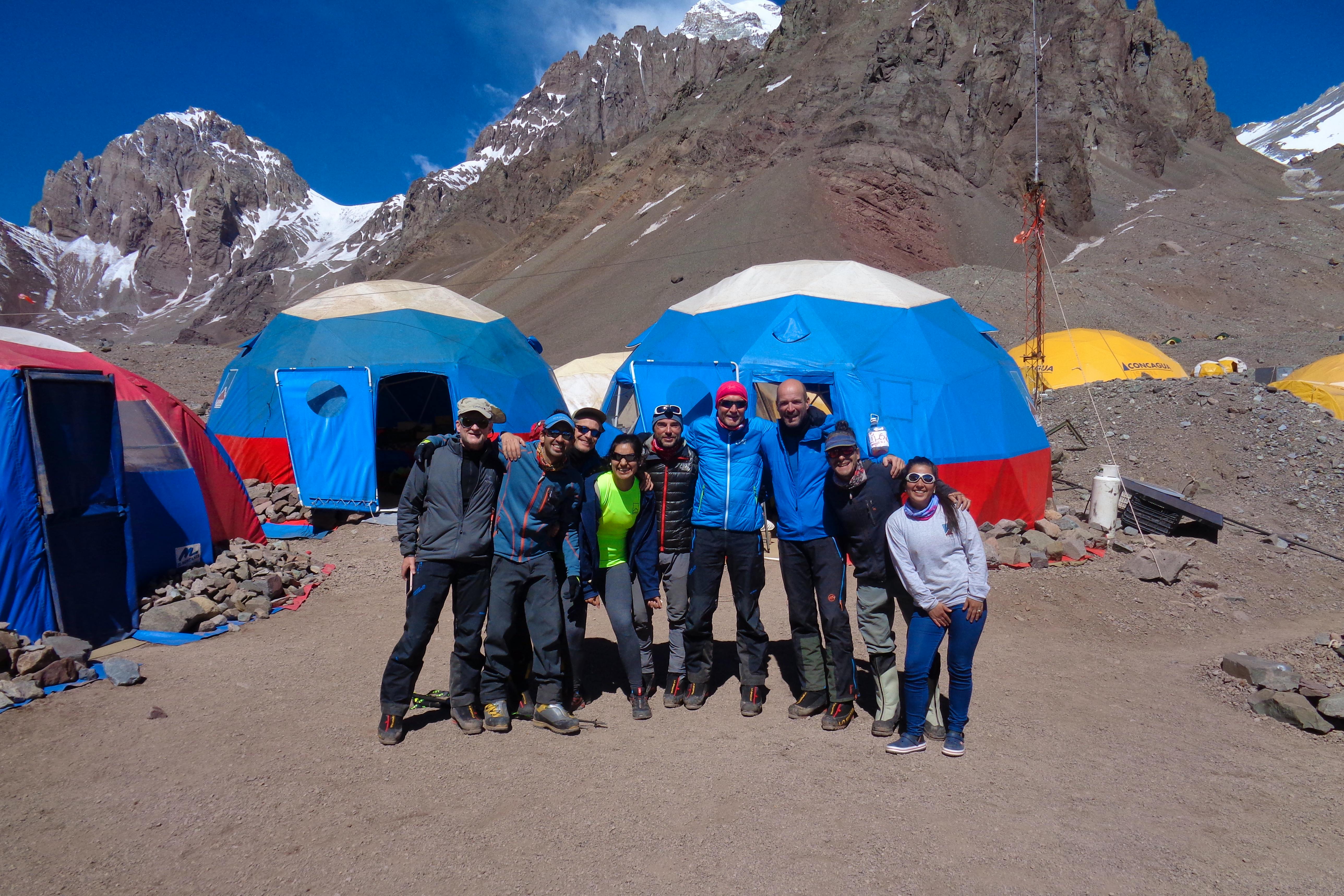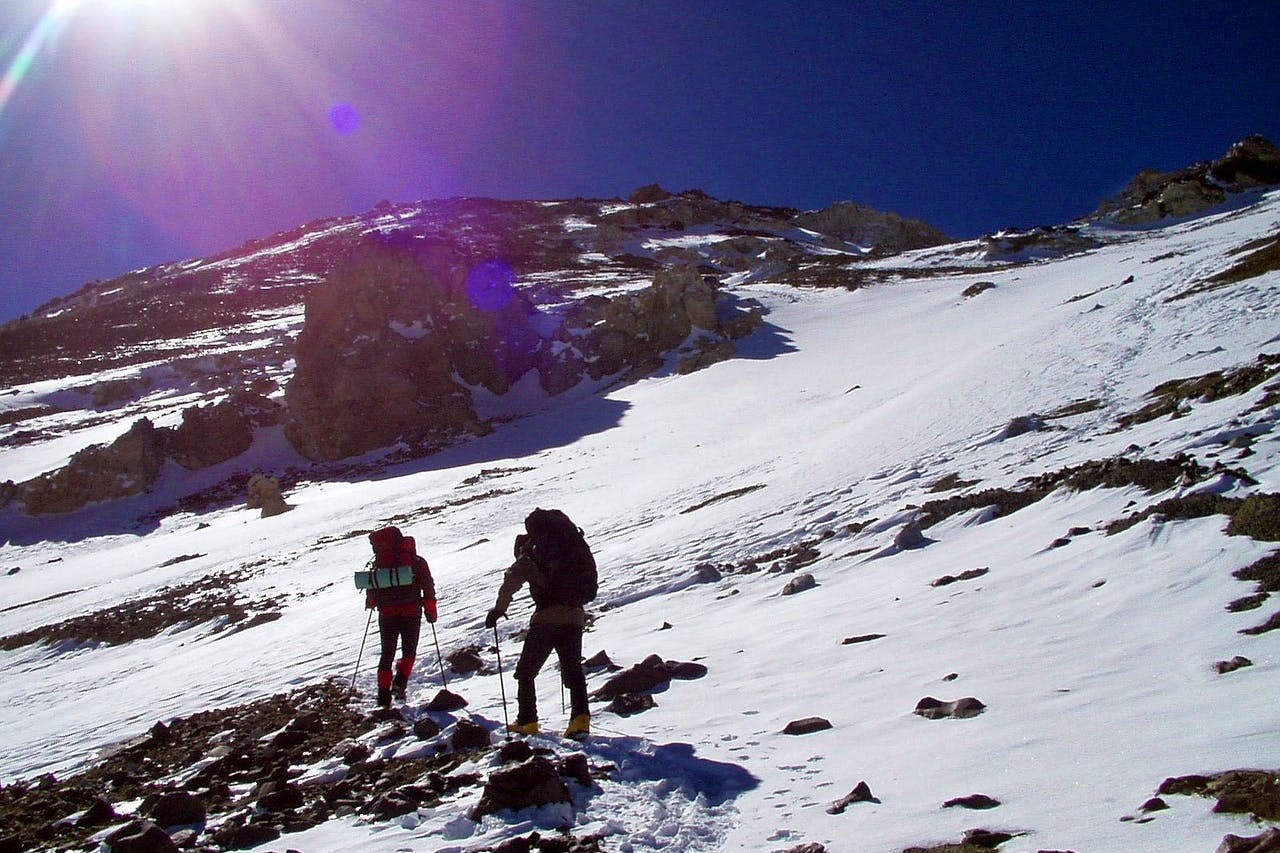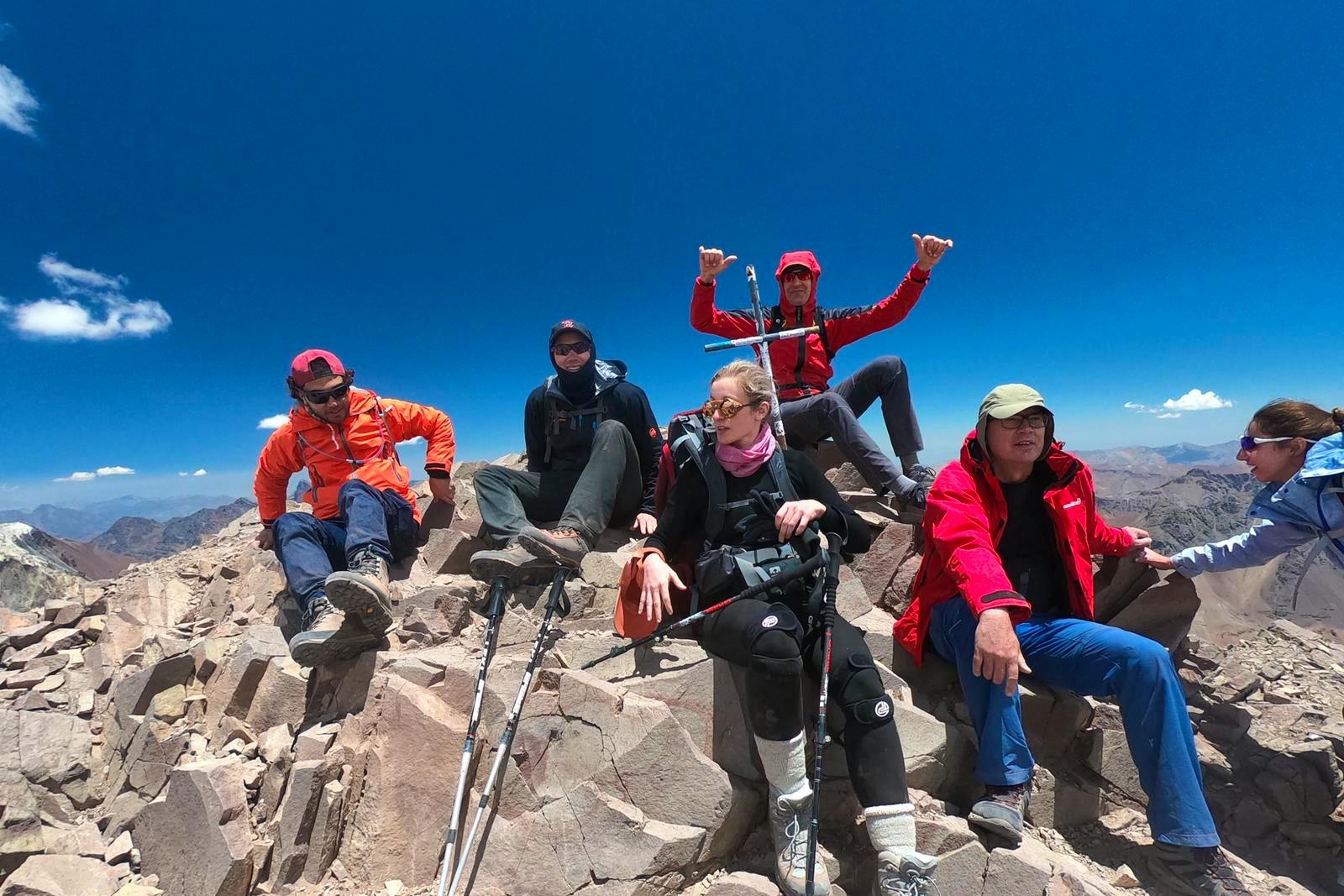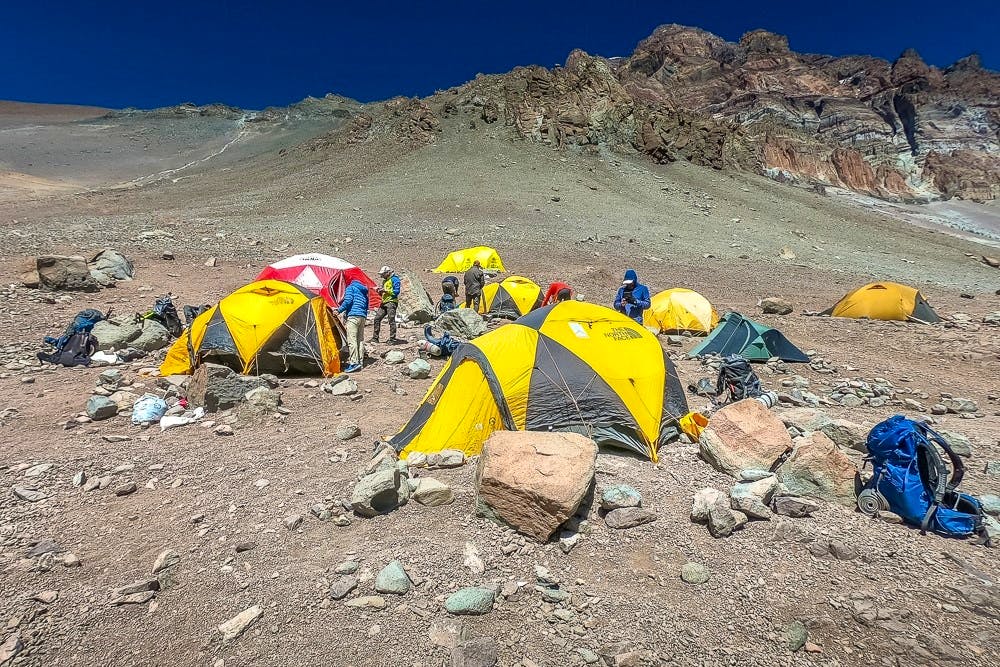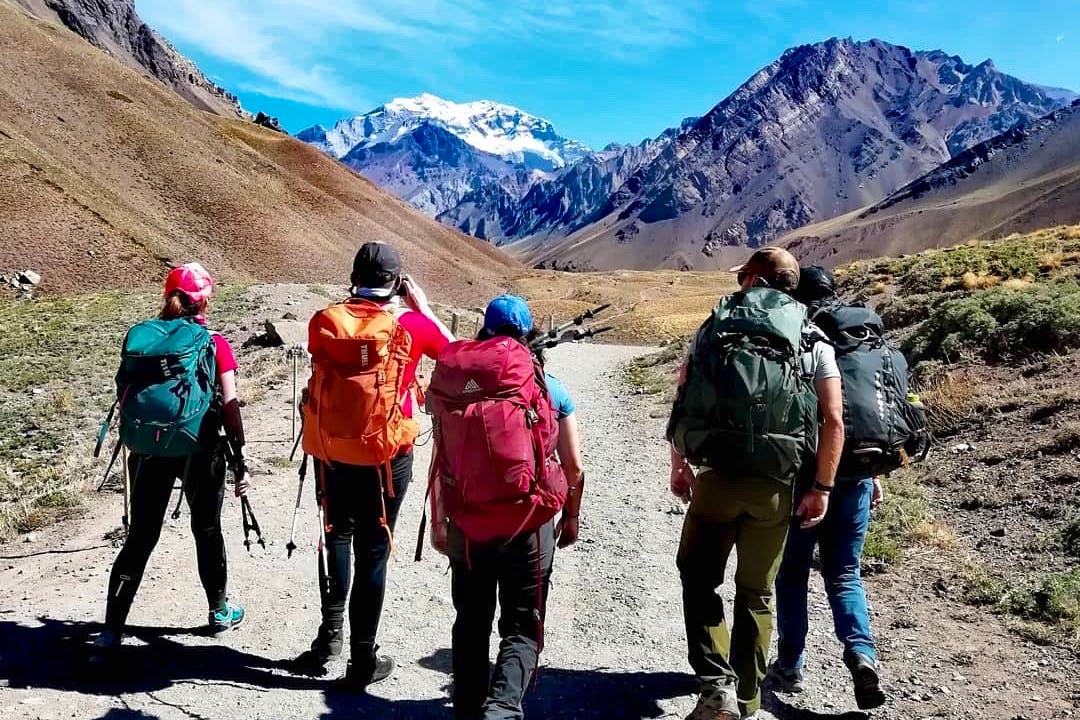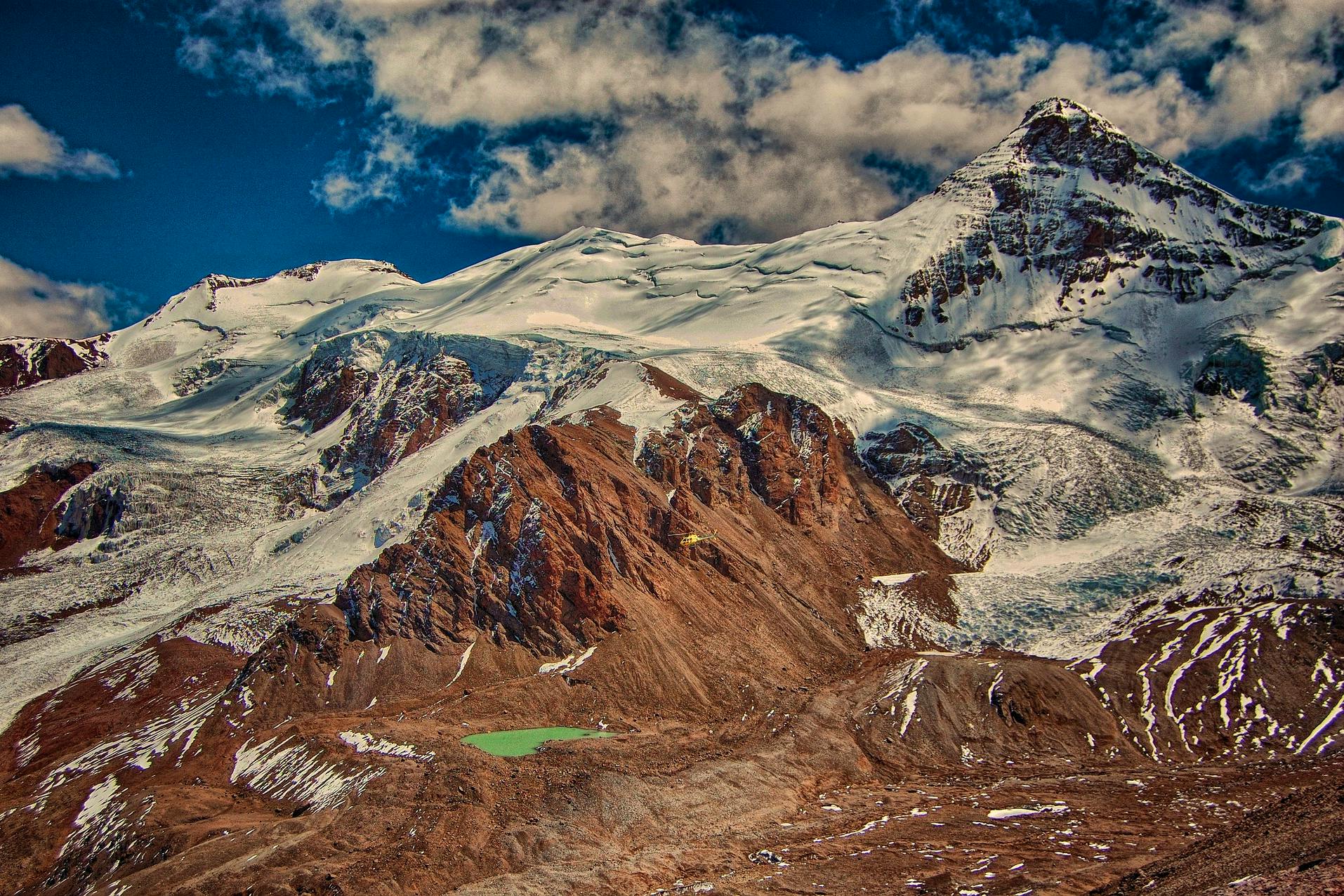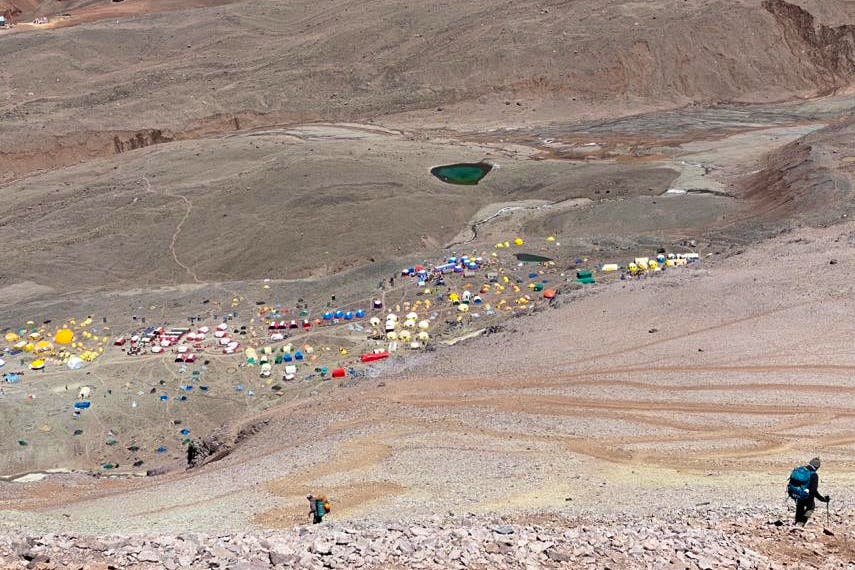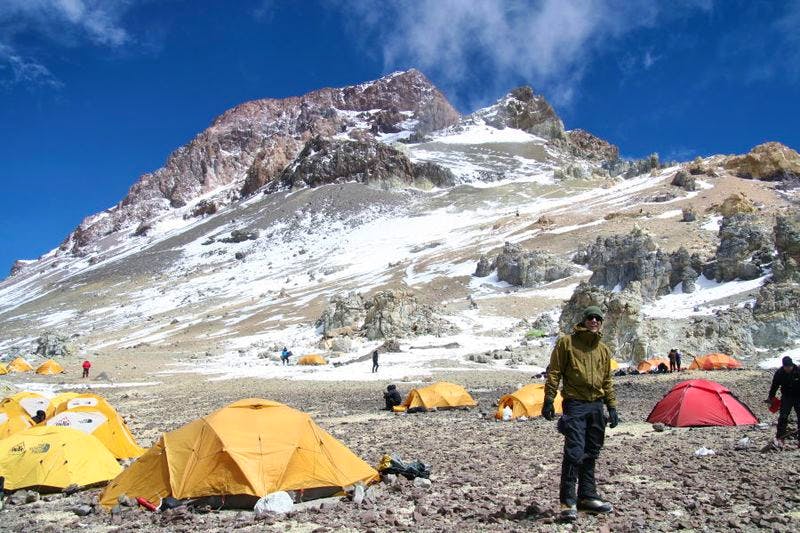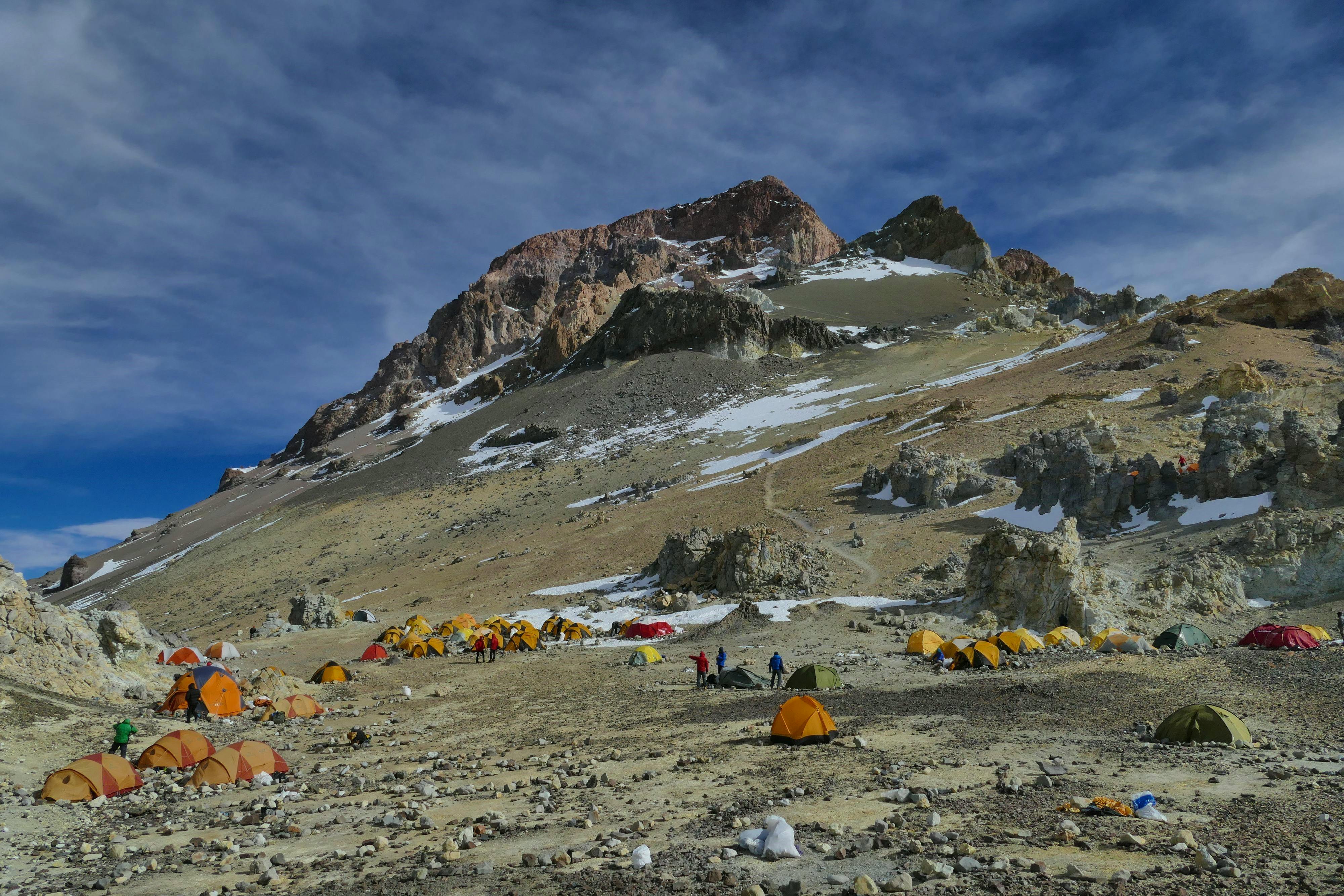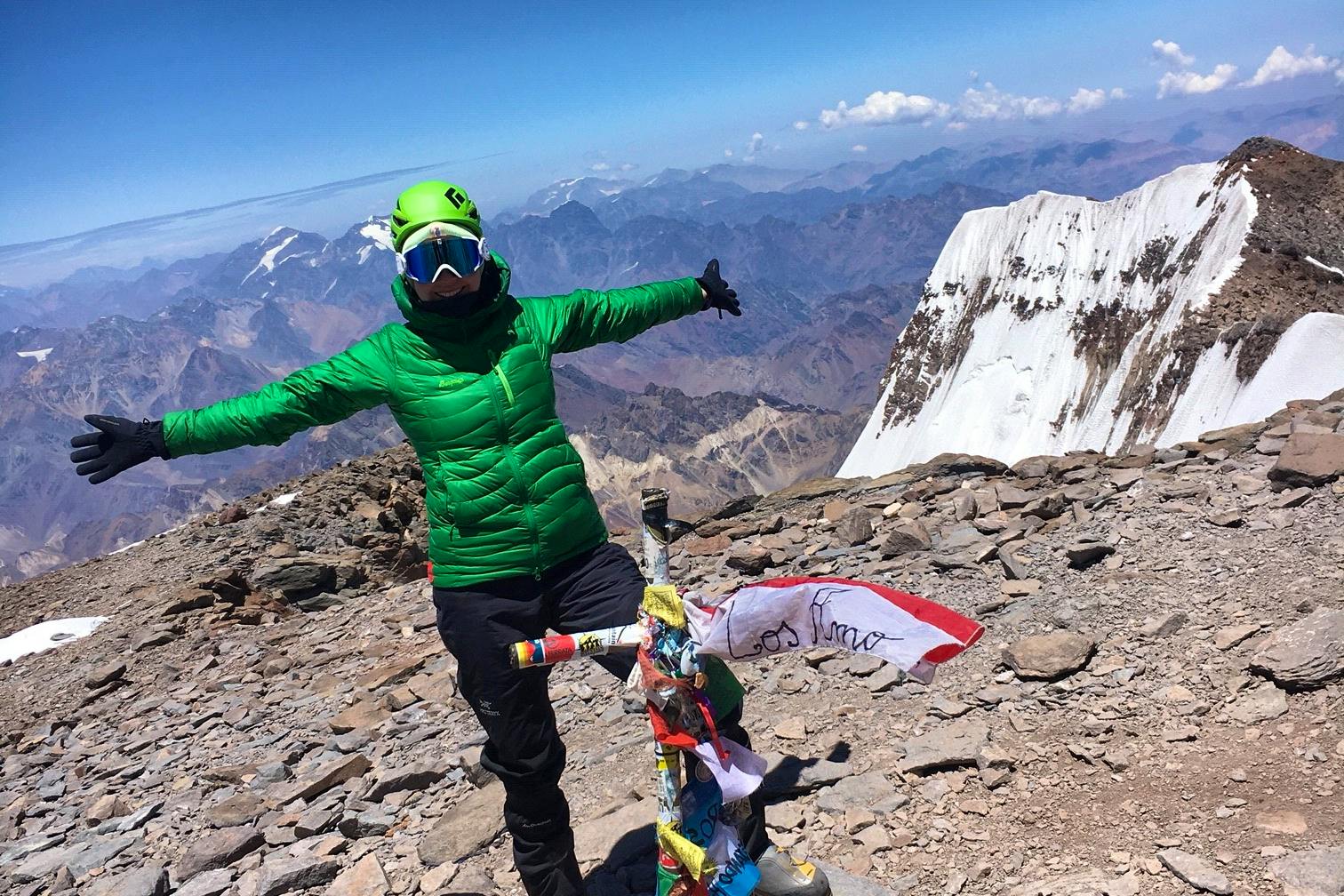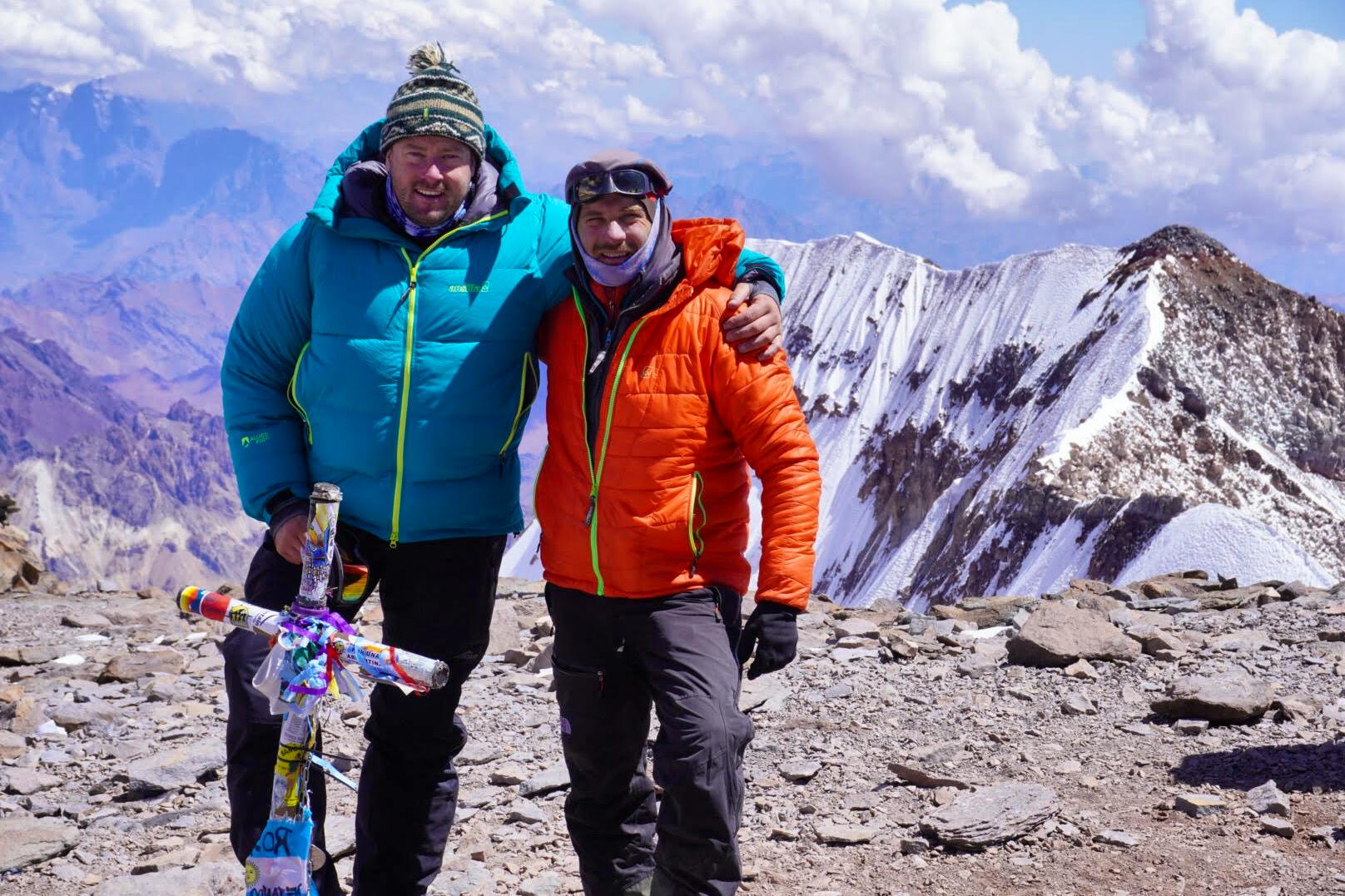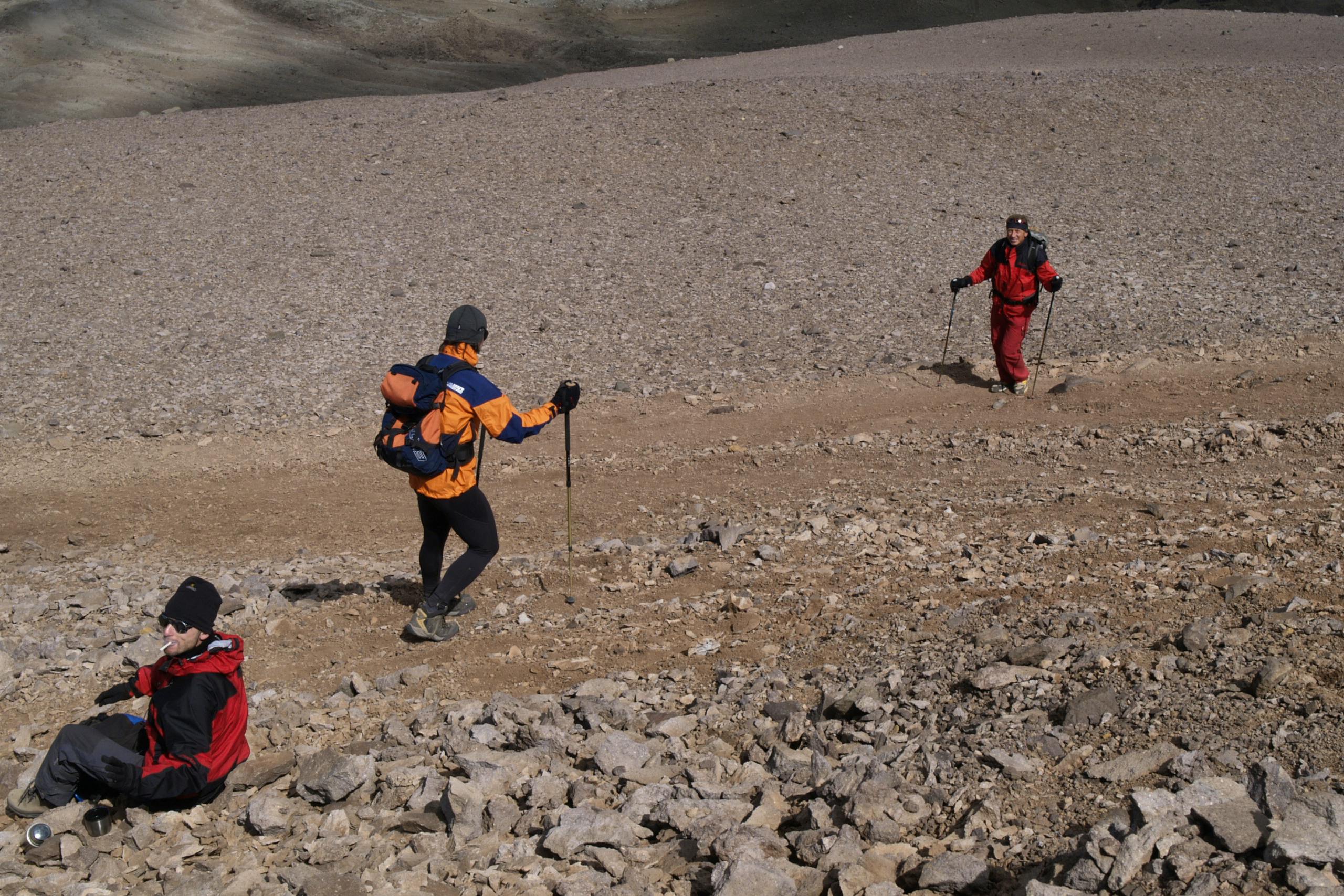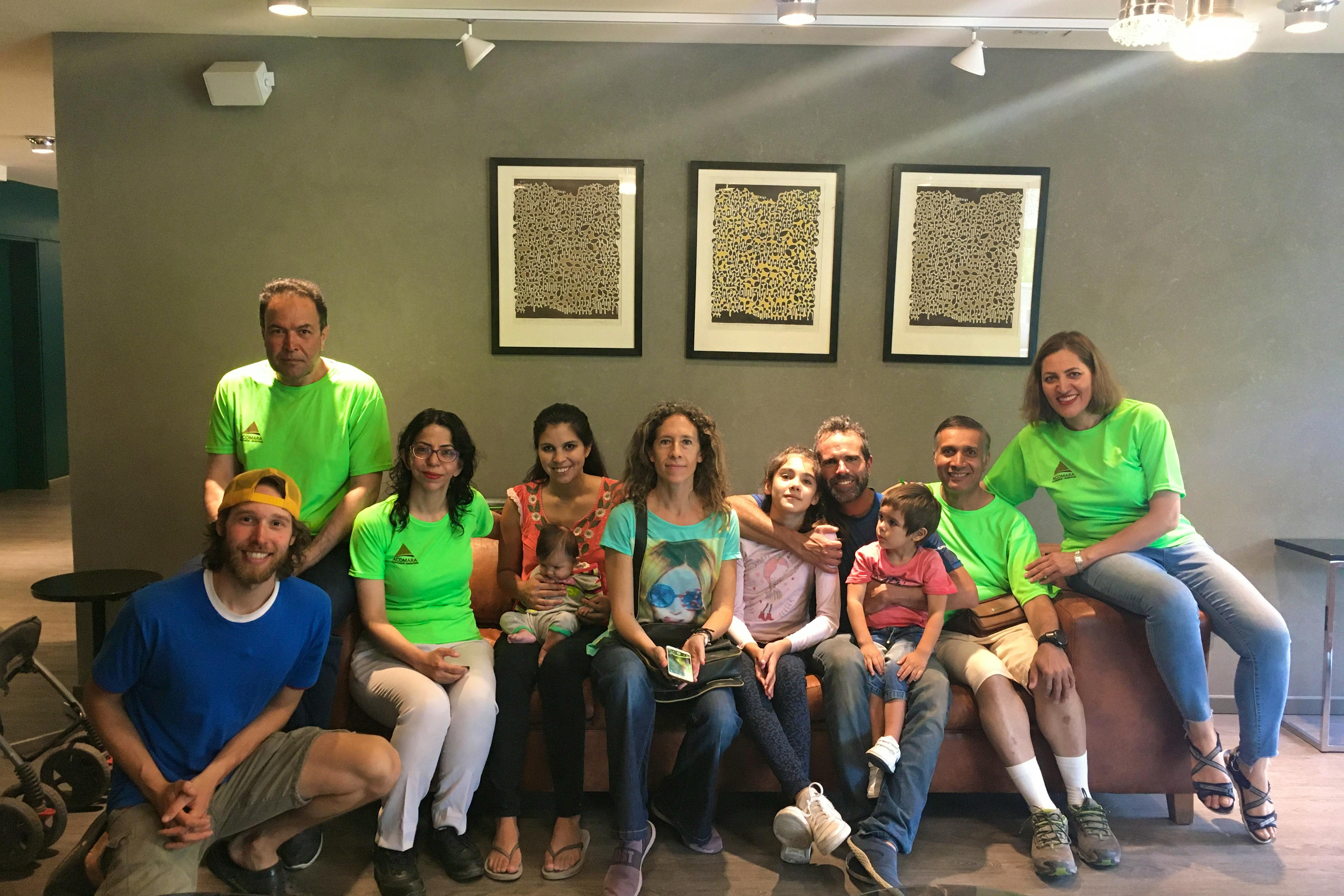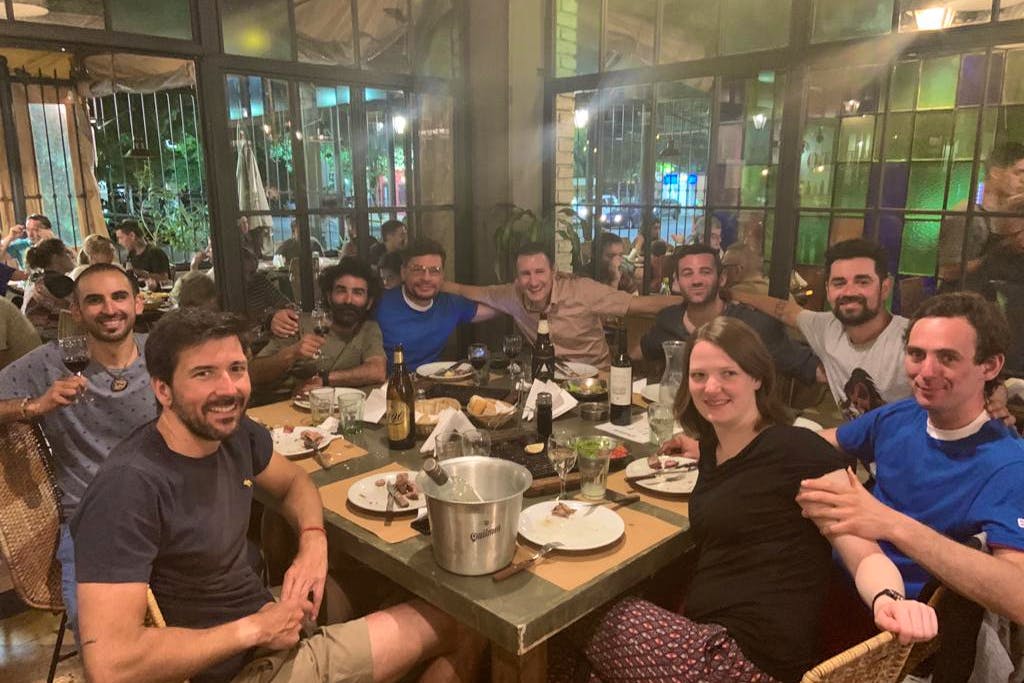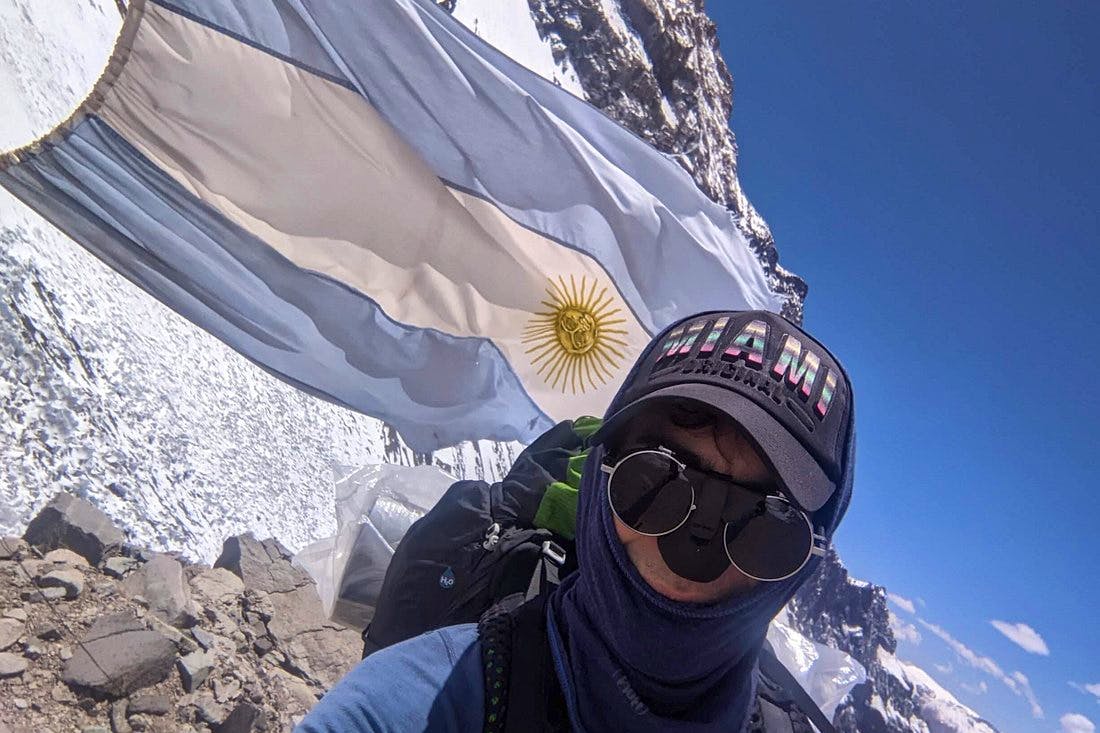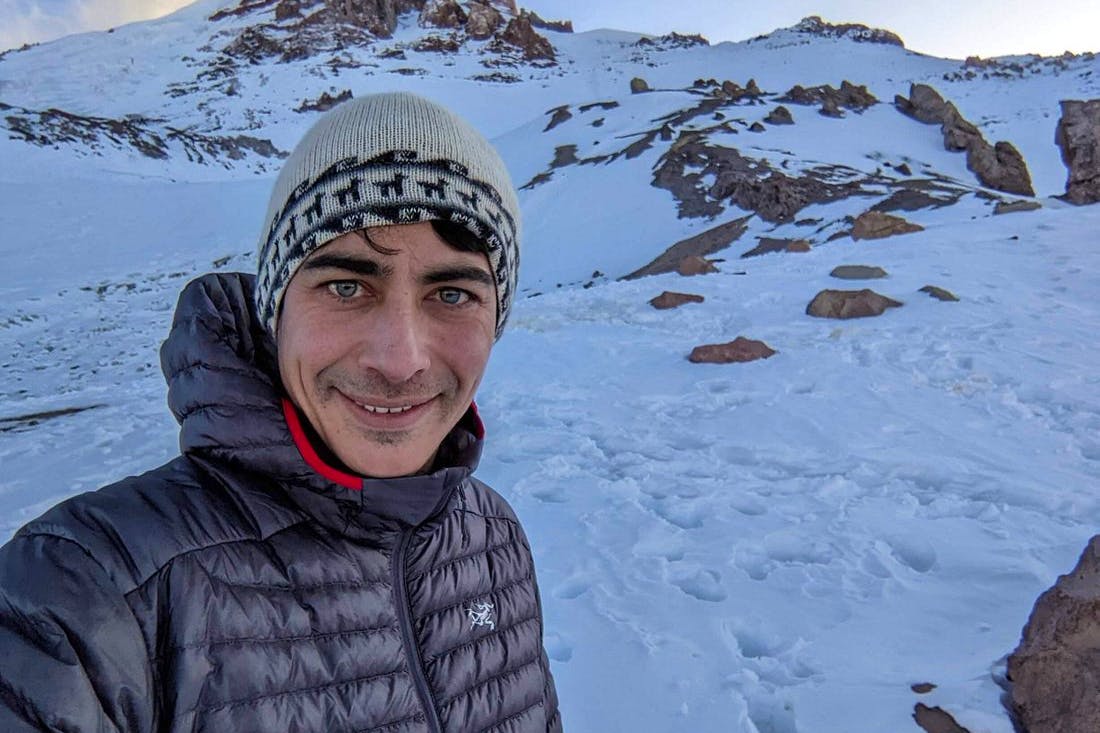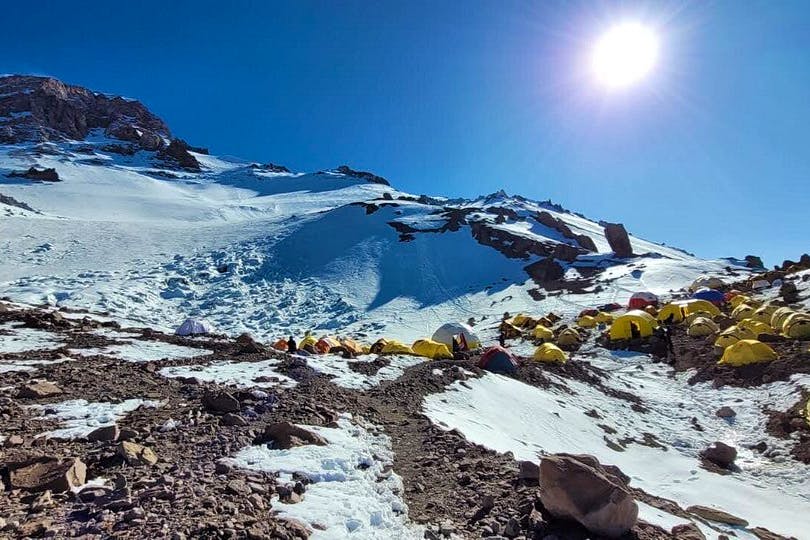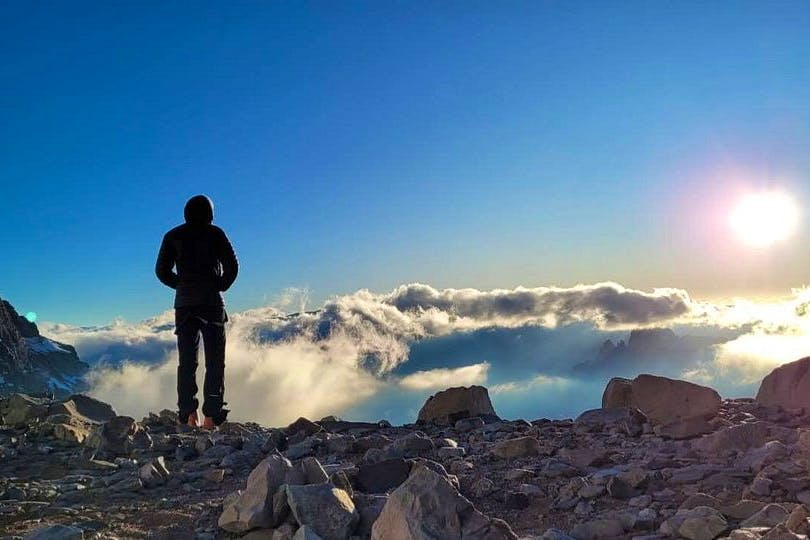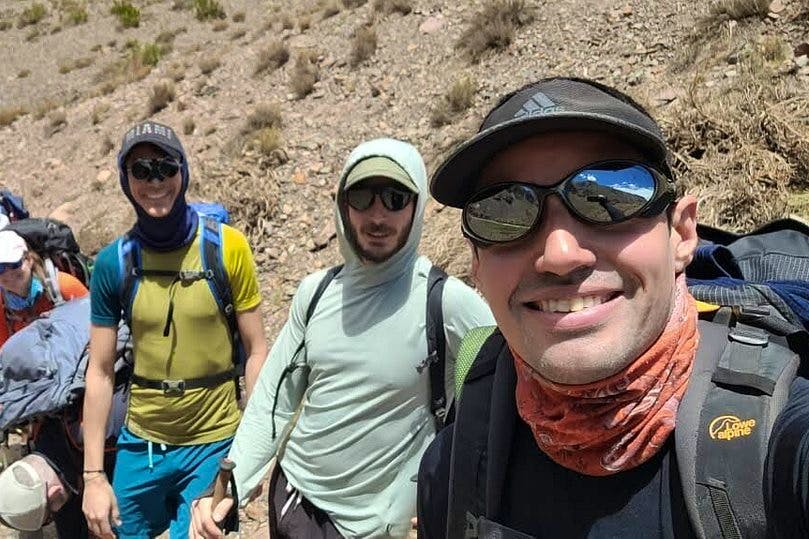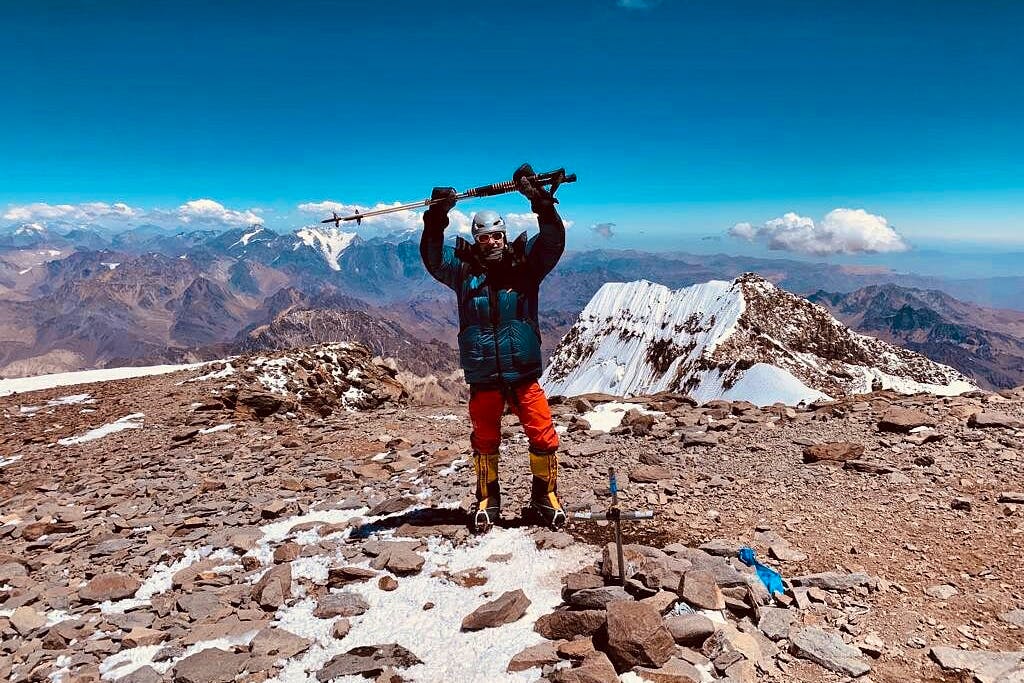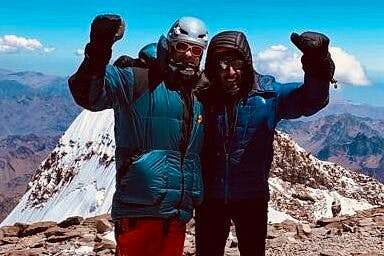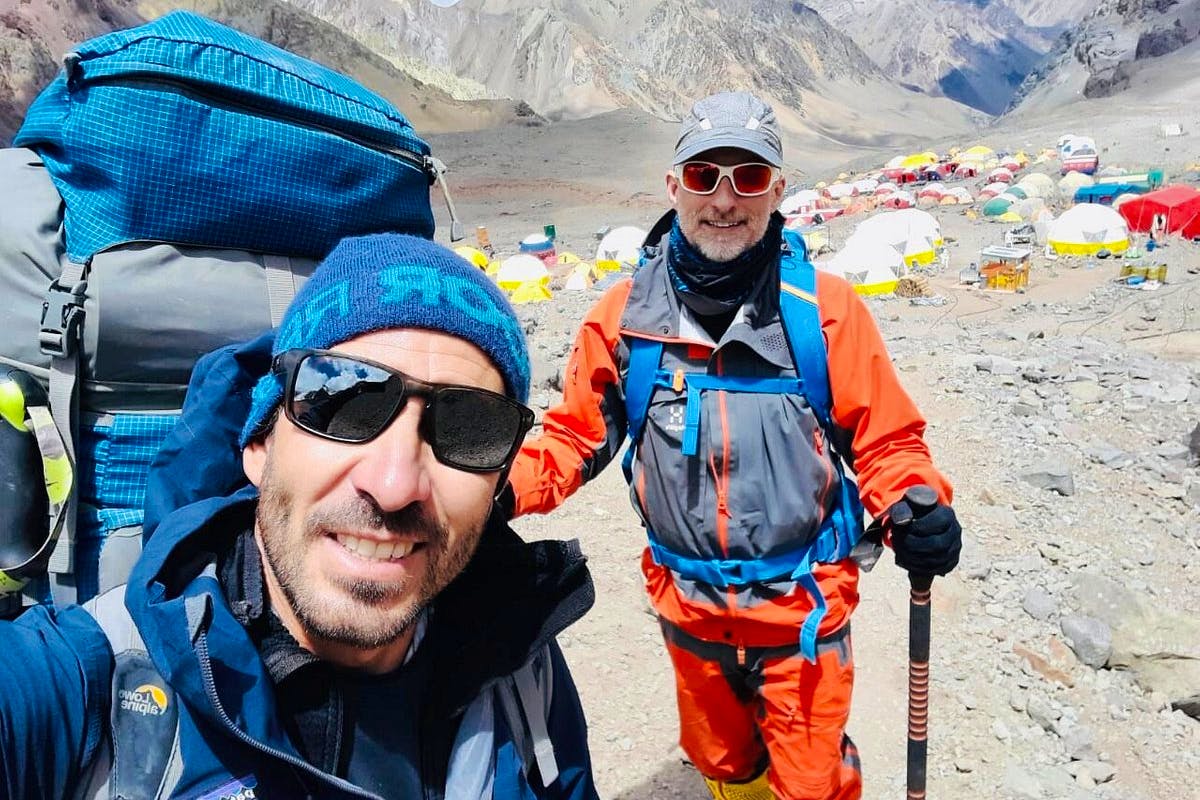Aconcagua Normal Route (6,962m)



Summit the tallest mountain in South America - one of the seven summits - on an epic expedition.
Itinerary
You'll check-in to your hotel in Mendoza, and have some time to relax. In the afternoon you'll meet the team and go through all the equipment for your expedition.
After a relaxed start to the day, you'll head over to Penitentes-Puente del Inca where you'll obtain your mountain permits.
After a hearty breakfast, you'll drive over to the entrance of the national park. From here, you'll make your way on foot to the Cofluencia Camp.
Today you'll go on an acclimatization trek to the south side of Aconcagua. In the afternoon you'll return back to Confluencia at 3,300m.
Follow the Horcones Superior River today as you head towards your base camp at Plaza De Mulas. You'll pass Horcones Glacier along the way.
It's time to give your body some time to acclimatize before moving higher. You'll spend the day learning axe and crampon skills.
You'll get to your first summit today, as you head for Mt Bonete. This will give your body an opportunity to experience higher altitudes, before heading back down to base camp at 4,260m.
You'll spend the morning hiking to Camp 1 - you'll carry food, fuel, and other supplies, which will be left there in preparation for your hike to higher altitudes over the following days. In the afternoon, you'll head back down to base camp at 4,260m.
You'll make your way to higher altitudes today, as you prepare the camp for your summit ascent over the coming days. The porters will carry all the tents, first aid kits, and garbage disposals. You'll be required to carry your personal equipment and any additional supplies you may need.
Today you'll have an opportunity to check your equipment and rest before heading up to higher altitudes.
By now, your body should be well acclimatised to the higher altitudes, and ready to edge closer to the summit of Aconcagua. You'll set up camp at Nido de Condores, where you'll stay for the next 3 nights.
An important rest and acclimatisation day today, as doing so will greatly improve your chances of successfully reaching the summit. Read a book, play some cards, or just soak in the views.
Today is a great opportunity to move your cooking equipment up to camp 3, while allowing your body the opportunity to acclimatise to the higher altitudes. In the afternoon, you'll head back to camp 2 at 5,250m.
You'll take all the camping equipment you need for your summit attempt and leave it there, before heading back down to camp 2 at 5,250m.
It's the big day today. All your preparation has been leading to this. You'll start early in the morning with hot drinks and a good breakfast, before starting your hike along the weaving route.
Traversing across the north face of Aconcagua, you'll reach a gully that leads up to the summit ridgeline. From here, the route leads across the ridge for a few hundred meters before reaching the summit. In the afternoon, you'll make your way back down to Camp 3 for dinner and a well-deserved rest.
Carrying the equipment from camp, you'll slowly make your way back down to base camp at Plaza de Mulas.
Carrying just your daypack, you'll head back to the park gate before driving back to your hotel in Mendoza.
After breakfast, you'll check out of your hotel. Airport transfer available for those heading home.
Because of the nature of such an expedition, it is important to include a contingency day. The above itinerary is a guideline only. Although the guides will make every effort to adhere to this, it is likely that changes will need to be made, due to weather conditions or other unforeseen events. Please ensure you allow for this extra day when booking travel arrangements.
Because of the nature of such an expedition, it is important to include a contingency day. The above itinerary is a guideline only. Although the guides will make every effort to adhere to this, it is likely that changes will need to be made, due to weather conditions or other unforeseen events. Please ensure you allow for this extra day when booking travel arrangements.
Book Now
All trips are guaranteed to runMon 1 Dec 11:00AM Sat 20 Dec 5:00PM | $6,150 ($799 deposit) Based on $6,150 USD | Book Just 3 spaces |
Sun 7 Dec 11:00AM Fri 26 Dec 5:00PM | $6,150 ($799 deposit) Based on $6,150 USD | Book Just 3 spaces |
Mon 8 Dec 11:00AM Sat 27 Dec 5:00PM | $6,150 | Fully booked |
Sun 14 Dec 11:00AM Fri 2 Jan 5:00PM | $6,150 | Fully booked |
Fri 26 Dec 11:00AM Wed 14 Jan 5:00PM | $6,150 ($799 deposit) Based on $6,150 USD | Book Just 2 spaces |
Mon 29 Dec 11:00AM Sat 17 Jan 5:00PM | $5,362.5 ($697 deposit) Based on $5,362.5 USD | Book Just 1 space |
Fri 2 Jan 11:00AM Wed 21 Jan 5:00PM | $6,150 ($799 deposit) Based on $6,150 USD | Book Just 3 spaces |
Mon 5 Jan 11:00AM Sat 24 Jan 5:00PM | $5,362.5 | Fully booked |
Fri 9 Jan 11:00AM Wed 28 Jan 5:00PM | $6,150 | Fully booked |
Mon 12 Jan 11:00AM Sat 31 Jan 5:00PM | $6,150 ($799 deposit) Based on $6,150 USD | Book Just 3 spaces |
Mon 19 Jan 11:00AM Sat 7 Feb 5:00PM | $6,150 | Fully booked |
Mon 26 Jan 11:00AM Sat 14 Feb 5:00PM | $6,150 ($799 deposit) Based on $6,150 USD | Book Just 3 spaces |
Mon 2 Feb 11:00AM Sat 21 Feb 5:00PM | $6,150 ($799 deposit) Based on $6,150 USD | Book Just 3 spaces |
What's Included
Included
- Professional mountain guides.
- High altitude porters for equipment (not personal belongings).
- Accommodation in Mendoza (4-star hotel).
- Accommodation on the mountains (camping).
- Accommodation in Penitentes (Mountain hut).
- Acclimatisation treks (as stated in the itinerary).
- Transport during the trip.
- All food on the mountain.
- Tents and cooking equipment.
- Radio communication.
- Emergency equipment (including oxygen tube).
- Certificate of achievement.
Not Included
- International flights
- Food in Mendoza.
- Mountain permit (costs around $800).
- Global Rescue and travel insurance.
- Visa (if applicable).
- Personal porters (see FAQs).
Have a question?
If you have any questions about this trip or want to speak with an expert, get in touch.
We're ready to help.



Rated 5.0
3 verified reviews
Ale
(Apr 2023)
Federico Savigny
(Nov 2022)
Clement
(Feb 2022)
FAQs
Before you go
The Normal Route, which you will be taking, does not involve any technical challenges, so prior experience in rock or ice climbing is not necessary. However, you may need to use crampons and fixed ropes for safety, depending on the route conditions (guidance will be given if this is the case). We recommend that you have prior experience reaching altitudes of approximately 6,000 meters before attempting Aconcagua (e.g. Kilimanjaro). It's not strictly necessary, but it will give you more confidence and knowledge of how your body deals with the altitude. In terms of fitness, you need a good level of aerobic fitness and the ability to carry loads of 10-12kg (you will be carrying your own equipment and personal belongings between camps). The summit day, in particular, is quite demanding, as you will be ascending from 5,950 meters at high camp to the 6,962-meter summit. This ascent can take between 7-10 hours, with a 2-4 hour descent. To get the best out of this trip, ensure that you are physically fit and accustomed to long days in the mountains.
Please see the Inclusions and Exclusions section above.
Feet: – 2 pairs of synthetic inner socks – 4 pairs of thick socks for cold (ski type) – 1 pair of comfortable trekking boots – 1 pair of gaiters Legs: – 1 pair of fine synthetic pants – 1 pair of thick shelter pants – 1 pair of rainproof pants – 1 pair of comfortable long pants (trekking type) Body: – 2 synthetic underwear shirts – 1 turtleneck of synthetic material – 1 fleece jacket or similar – 1 shelter jacket (down or synthetical) – 1 rainproof jacket Head: – Sun cap or hat – Shelter hat (wool or fleece) – Light ski mask – A good pair of sunglasses with UV filter and nose and side protection – A pair of ski goggles – A handkerchief for the neck Hands: – 2 pairs of light inner gloves – 2 pairs of rainproof gloves for shelter (mitten type) – Wet wipes Expedition material: – Book or anything that helps to be entertained in the tent – Sunscreen – Water bottles for three litres in total – 6 pairs of hand warmers – Sleeping mattress for high mountain – Personal toiletries – Front lamp with extra batteries – Stainless steel thermo (1L or 0.5L) – Personal crockery (bowl, cup, fork, and spoon) – A synthetic or down sleeping bag for – 35 º C Technical equipment: – 1 comfortable backpack of 80 litres – 1 pair of double or triple boots for high mountain (suitable for 7,000m and – 40ºC temperature) – Crampons – Poles (optional) – 1 helmet
The mountain permit prices vary depending on seasonality and time before departure. As such this permit is unfortunately NOT INCLUDED in the trip price. Permits cost around $800 We will be in touch after booking to help you arrange this.
It’s highly recommended you take out personal travel insurance. Travel cover protects you in the case of unforeseen circumstances including cancellations, injuries, equipment loss, flight changes and other events that could negatively impact your trip. We suggest specialist adventure travel insurers, [Rise & Shield](https://riseandshield.com/). They cover 100s of activities and are easy to deal with if you need to make a claim. They also cover unique scenarios, like trekking at altitude or emergency evacuation in hard-to-reach places, that ordinary travel insurance doesn’t cover.
On your trip
Summit success can never be guaranteed, as various factors may force you to abort the attempt. These factors include weather conditions, health issues, fitness levels, ability, or other unforeseen circumstances. The guides always prioritize your safety while on the mountain. If a climber is unable to continue ascending, one of the group's guides will descend with that individual while the rest of the group proceeds upward with the remaining guides. This process continues until only one guide remains. If a situation arises where a single guide is left with two or more climbers and someone needs to descend, the entire group must go down. For safety reasons, no one is permitted to be alone on the mountain without guiding assistance.
The porters will handle the transportation of tents, trash, cooking gear, fuel, first aid kits, oxygen tubes, toilet paper, and other team-related equipment. During acclimatisation treks, you will be responsible for carrying some food, as well as your personal equipment when transitioning between camps. The porters will not carry your personal belongings. Your backpack is generally 16 kilos since, at altitude, the heaviest thing is the boots; by then, you already have them on. The water and food you will be carrying rarely reaches 10 kilos. It is important to clarify that if a passenger has to carry his equipment during some stretch, they will not carry water or food during the same stretch, and vice versa. If you wish to hire a porter specifically for your personal items, please feel free to message your head guide directly (either from the trip page or from your dashboard after booking).
Horcones / Confluencia Estimated max altitude: 10,890ft - 3,300m Estimated distance: 8 km Estimated time: 4 hours Confluencia / Plaza Francia / Confluencia Estimated altitude: 13,200ft - 4,000m Estimated distance: 22 km Estimated time: 6 - 7 hours Confluencia / Plaza de Mulas Estimated max altitude: 14,058ft - 4,260m Estimated distance Confuencia / Playa Ancha: 10 km Estimated distance Paya Ancha / Plaza de Mulas: 9 km Estimated time: 7 - 10 hours Plaza de Mulas Short trek to Horcones Glacier Plaza de Mulas / Mt. Bonete Summit / Plaza de Mulas Estimated max altitude: 16,732ft - 5,091m Estimated distance: 16 km Estimated time: 7 - 8 hours Start high altitude trek: Plaza de Mulas / Camp 1 Plaza Canada / Plaza de Mulas Acclimatisation day 1 on high altitude Estimated max altitude: 16,203ft - 4,910m Estimated distance: 7 km Estimated time: 5 - 6 hours Plaza de Mulas Resting Day Plaza de Mulas / Camp 1 Plaza Canada Moving day Estimated max altitude: 16,203ft - 4,910m Estimated distance Plaza de Mulas / Piedras Conway: 1 km Estimated distance Piedras Conway / Plaza Canada: 2 km Estimated time: 3 - 4 hours Camp 1 Plaza Canada / Camp 2 Nido de Condores Moving day Estimated max altitude: 17,325ft – 5,250m Estimated distance Plaza Canada / Cambio de pendiente: 2 km Estimated distance Cambio de pendiente / Nido de Condores: 1 km Estimated time: 4 - 5 hours Camp 2 Nido de Condores / Camp 3 Colera / Camp 2 Acclimatisation day 2 on high altitude Estimated max altitude: 20,000ft - 6,000m Estimated distance: 4 km Estimated time: 5 - 6 hours Camp 2 Nido de Condores / Camp 3 Colera Moving day Estimated max altitude: 20,000ft - 6,000m Estimated distance: 2 km Estimated time: 3 - 4 hours Camp 3 Colera / SUMMIT / Camp 3 Colera Summit day Estimated max altitude: 22,834ft – 6,962m Estimated distance Colera / Independencia: 2 km Estimated distance Independencia / Summit: 2 km Estimated total distance on summit day: 7 km Estimated time: 7 - 11 hours Camp 3 Colera / Plaza de Mulas Estimated distance: 7 km Estimated time: 6 hours Plaza de Mulas / Penitentes / Mendoza Estimated distance: 26 km (not physically demanding) Estimated time: 7 - 8 hours
Although the itineraries are carefully designed to allow for proper acclimatisation, you may still experience altitude sickness and oxygen deprivation during the trek. Be aware that your guide has the authority to determine if it is unsafe for you to continue and may arrange for you to descend to a lower altitude if necessary. When ascending above 2,500 meters, it is crucial to allow your body time to acclimatise to the lower oxygen environment. The itineraries are structured to facilitate this process by following longer routes during the ascent phase or incorporating rest days at specific altitudes. These measures help ensure a safer ascent and a more enjoyable experience. High altitude sickness can affect anyone, regardless of age or fitness level. Hastiness in the mountains can be life-threatening. Your body can adjust to high altitudes, but only if given sufficient time. If you experience symptoms of altitude sickness, it is imperative to descend immediately. Symptoms may vary between individuals and can include headaches, nausea, numbness in the fingers, or heavy breathing. If you encounter such symptoms, it is advisable to halt your ascent. Drinking plenty of water may also help alleviate these issues. Remember to pace yourself, avoid rushing, and protect yourself from the elements while trekking at high altitudes.
You can get from the airport to Mendoza centre by bus or by taxi. Mendoza city has one airport [MDZ]. There is also only one bus station (Terminal del Sol).
Base Camp Specialised chefs prepare all meals, which are served in dining tents. The regular menu includes: Breakfast -coffee, tea, milk, chocolate, cereals, bread, ham, cheese, crackers, cookies, pudding. Lunch & dinner - various cream soups, assorted meat dishes, chicken dishes, pasta or rice with sauce, pizza, tuna, salads, etc. Dessert -fresh fruit, mousse, sweet potato. Altitude Camps Guides prepare all meals and are responsible for water provision. The regular menu consists of: Breakfast - coffee, tea, milk, chocolate, cereals, bread, ham, cheese, crackers, cookies, pudding. Lunch & dinner- various cream soups, pasta or rice with sauce, tuna, and pre-cooked meals. Dessert - chocolate, canned fruit, sweet potato. Additional items provided by guides: candy, cookies, cereal bars, power gels, snacks, dried fruit, olives, etc. Mendoza While staying in the city, breakfast is included at the hotel. However, lunch and dinner are not provided. Vegan and vegetarian options are available upon request. Please inform us in advance to accommodate your dietary needs.
On expeditions from base camp to the summit, there is an average of 7 climbers accompanied by 3 highly professional and experienced guides. For groups with a maximum size of 12, there will be 4 guides. All guides are proficient English speakers, hold either AAGM or EPGAMT licenses, and are legally authorized by the Park authorities to lead treks in the area. Their extensive experience ensures a well-guided and safe expedition.
The guides carry a range of safety equipment to ensure the well-being of the group. Their first aid kits include: - Oxygen - Oximeter - Basic medicines for altitude sickness (note that these can be used only with a doctor's approval due to legal reasons) - Band-aids, gauze, and disinfectant for wound care Aconcagua is equipped with a rescue patrol, including doctors, who take control in case of any medical emergencies. The guides, with their 20 years of experience on Aconcagua, have not encountered any major medical issues during their expeditions.
Start: Your guide will meet you at the specified hotel in Mendoza, on day 1 of the itinerary. The team in Argentina will provide details of the hotel address around 5 to 10-days before your trip. End: Your trip will end on either day 18, 19, or day 20 at your hotel in Mendoza. This depends on whether the bad weather days are used. It is important that any international flights are booked from day 20 onwards.
Pitching of tent is an activity involving all the climbers and guides. Don't worry, you will get a lot of assistance with this.
We sleep in domes at base camp. The domes have capacity for 8-12 people. If passengers want to sleep alone at the base camp, they can hire a single tent ($149) In high-altitude camps, the passenger shares the tent with another passenger. This shared sleeping arrangement is for safety reasons and we cannot offer a single tent at these high altitudes. Note that the porters will carry the tents.
On average, our expeditions have between 6 and 9 people; if more than 10 people join on a particular date, we usually divide the groups into two so that the groups are smaller. The guide ratio is one guide for every three passengers from the base camp. All dates are guaranteed, regardless of the minimum number of passengers.
Other FAQs
While tipping is not obligatory in Argentina, it is generally expected. A recommended tip for your guides ranges from $150 to $300, which will be distributed among all those involved. However, feel free to tip more or less according to your satisfaction level.
The amount of spending money you will need largely depends on your personal spending habits, such as souvenir purchases and refreshments. Additionally, you must factor in the cost of a climbing permit, which can vary (message us for the latest updates). In 2023, the permit prices were $800. If you return to Mendoza on the 18th day (without using the extra days), you will need to cover the cost of 2 extra nights of accommodation in Mendoza. A 4-star hotel typically charges $100 per person, per night.
Yes, just let the guides know when completing your participation form. Depending on the requirement, there may be an additional charge.
Your head guide is Fernando
All trips on Skyhook are run by small, hand-picked local guiding companies. For this trip you'll be led by Fernando.
By booking through Skyhook you'll be joining a small-group trip. This can make it nice and sociable (you'll be added to a group chat after booking), and guarantees great value for money!

Why Skyhook?
Join over 27,000 Skyhook adventurers who've used our platform to book directly with our vetted local guides, at local prices (we never markup).
Expert Local Guides
Experienced local guides, handpicked by us.
Best Prices
Never pay a markup on the local guide's price.
Exclusive Club
Earn loyalty rewards every time you travel.
Great Social Vibes
Small group tours provide a richer experience.
Stellar Feedback
Over 2,800 reviews, average of 4.9/5 stars.
